Chefchaouen Morocco: A First-Timer's Guide to the Blue Pearl
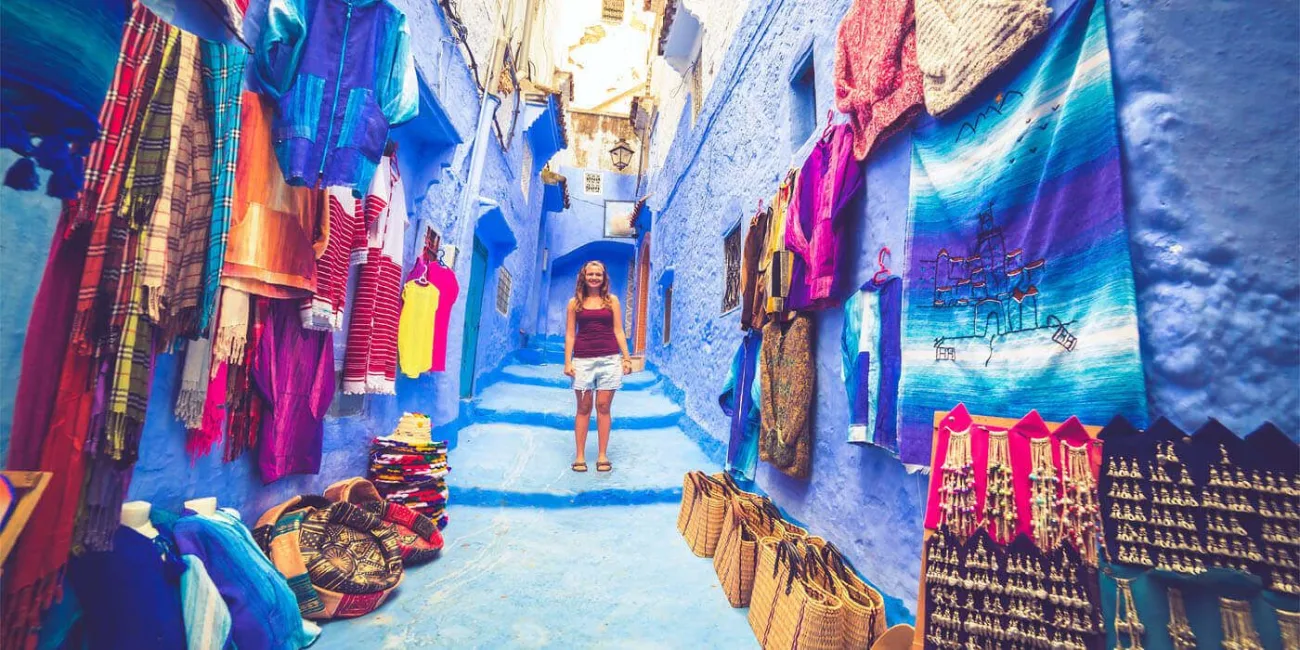
Chefchaouen is known to be one of the most peaceful and serene towns in Morocco. It is a gorgeous city in northern Morocco.
Attracting all types of travelers and adventure seekers, a city is a relaxed place with affordable prices for those who seek calmness and good quality with reasonable accommodation. It is perfect for a day trip.
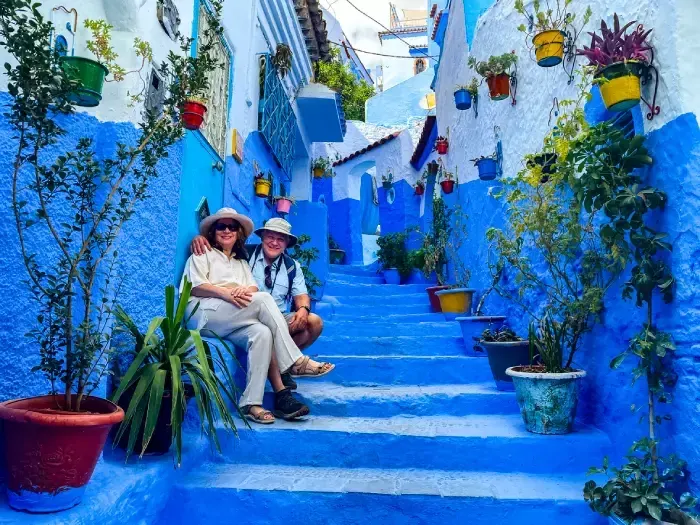
Locals say the blue symbolizes the sky and heaven, and honestly, it makes the town magical.
Yes, Chefchaouen is a must-visit. I loved wandering its peaceful, blue-painted streets.
Chefchaouen at a Glance
Chefchaouen or Chaouen, as the local Moroccans call it, is known as the “Blue Pearl” of Morocco. This is because the inhabitants paint all of the buildings blue. No one knows exactly why this is done.
There are two main theories. The first is that the blue color keeps the mosquitoes away. The second theory is that according to the Jewish tradition it is believed that the color blue represents the sky which in return reminds people of heaven and God.
It serves as a reminder to lead people’s spiritual and moral lives. Regardless of the real reason, the color covering the city gives it an amazing charm, calmness, and joyful spirit.
The mountainous surroundings give this sweet town an illusion of isolation from the crowded and loud world outside. The city has an atmosphere of relaxation, comfort, and peace. It is the perfect place to go on a vacation.
The city of Chefchaouen and the surrounding area have a population of almost 43,000 people. It is a small and quiet town. It was founded in 1471 by Mulay Ali ibn Rashid al-Alami to defend against the newly Portuguese-controlled Ceuta
It used to serve as a Moorish fortress for exiles from Spain. For ages, the city grew and welcomed different religions like Jews and Christian converts alike. Today it is a wonderful cultural mix between Christians, Jews, Berber tribes, and Muslims, all living together in peace and tolerance.
Morocco is a rich country in history and culture, make the best use of it through one of our Morocco Travel Packages!
Yes, it’s safe to travel to Morocco from the USA. I just kept updated on travel advisories before my trip.
Location of Chefchaouen
Being located in the area of the Rif Mountains, exactly on the northern tip of Morocco. It is about five hours north of Casablanca and two hours south of Tangier.
How to Get There by Bus?
The city is easily accessible. The most popular route is from Fez, it takes almost 4 hours. It also takes only 2-3 hours from Tangier. After that, you need to take a taxi to Medina. It only costs 10-15 MAD. You should give exact change.
Note, if you leave from Tangier, there are two bus stations: the Gare Routier de Tanger and the CTM.
CTM's distinguished fleet maintains steadfast connections to Chefchaouen. Grand taxis, following age-old customs, commence their journey upon achieving full occupancy. Private transfers, while commanding premium rates offer unmatched convenience.
Scholarly travelers should note the sacred rhythm of Ramadan affects transit patterns, while Spanish holiday festivities during late March and early April draw considerable crowds.
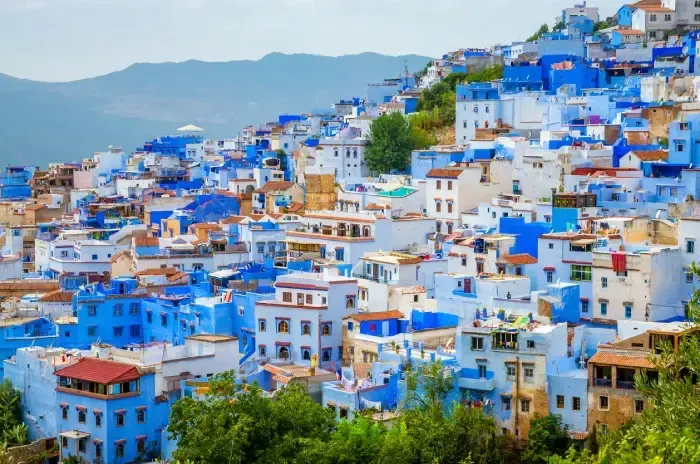
Chefchaouen is known for its blue buildings, mountain views, and relaxed atmosphere.
Customize Your Dream Vacation!
Get in touch with our local experts for an unforgettable journey.
Plan Your TripPlanning Your Trip to Chefchaouen
You need to plan your visit to Chefchaouen with weather patterns and travel logistics in mind. Let me help you make the most of your trip to this mountain gem.
The best time to visit
The best time to visit Chefchaouen is during spring (March-May) and fall (September-November). Spring temperatures range from 13°C to 24°C, making it perfect to walk through the blue-painted streets. The weather stays just as nice in fall with temperatures between 15°C and 26°C.
Summer can get quite warm with temperatures up to 35°C. The city also gets crowded from June through August. Winter brings cooler weather between 8°C-18°C, but you'll find fewer tourists and better deals.
How many days to stay
Two full days will give you enough time to see what makes Chefchaouen special. You can spend your first day in the medina and catch the sunset from the Spanish Mosque. Your second day is a chance to visit Talassemtane National Park, where you can hike to God's Bridge and Akchour Waterfall.
If you want to take it easy, you might want to stay for three days. This gives you time to learn about local culture, take cooking classes, or just relax in this peaceful mountain setting.
Walking routes for first-timers
The scholarly exploration of Chefchaouen's mysteries commences at Hotel Parador, adjacent to Plaza Uta El Hammam. The eastern path beckons, leading pilgrims across ancient bridges toward the Spanish Mosque - a quarter-hour journey yielding spectacular vistas of the azure city below.
The medina's masterful design reveals its secrets gradually, its proportions perfectly suited to mental mapping. Earthen-hued structures mark the periphery, standing in stark relief against the brilliant blue heart of the old city. Deep within these passages, master artisans practice their crafts - leather workers, spice merchants, and weavers maintaining centuries-old traditions.
Dawn presents Chefchaouen's most magnificent aspect before tour groups disturb the morning stillness. A hidden trail, branching right from the main gate, ascends to a privileged vantage point, presenting the blue city in all its splendor. This elevated path descends gracefully to the bazaar district, completing nature's perfect circuit.
The medina stands apart from its Moroccan counterparts, offering gentler commerce and more contemplative passages. A dignified refusal suffices where other cities might demand more forceful responses, allowing visitors to contemplate this mountain sanctuary's timeless beauty.
In Chefchaouen, the blue color represents spirituality and calm; it’s part of the city’s charm.
Things to Do in Chefchaouen
The greatest thing about Chefchaouen Morocco, would be the buildings that are painted in brilliant sky blue, which gives the city the name of the “blue city”. Also, the clear mountain light that falls on the city gives it a magical touch.
It is definitely a magical destination with beautiful landscapes and interesting activities to do.
1. Take Unforgettable Photos
Taking photos at Chefchaouen for your social media channels is a must. The city is unique where which should be documented with beautiful photos. The small streets and alleys are quiet and not crowded with cafes and shops.
The light and the blue color shift throughout the whole day, making every spot you see new over and over.
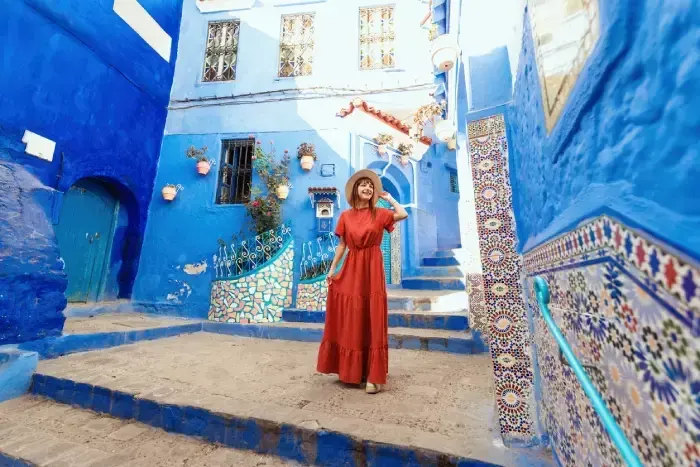
It’s called the Blue City because nearly every wall and door is painted a beautiful shade of blue.
2. Interact with the Cats
An interesting fact about the city is that you will find so many cats on the streets. Seeing them in the blue city is kind of special and different. However, be careful if you get bitten by an undomesticated cat. It this happens, head right away to the hospital and avoid the risk.
3. Buy Souvenirs
Buying souvenirs from any spot you visit is a remarkable experience. It is not the cheapest here in Chefchaouen but it is worth it.
You can choose to buy lots of products including textiles, rugs, straw bags, hats, leather stools, slippers, dresses, and blankets. Artwork and handmade crafts are all here at a reasonable price.
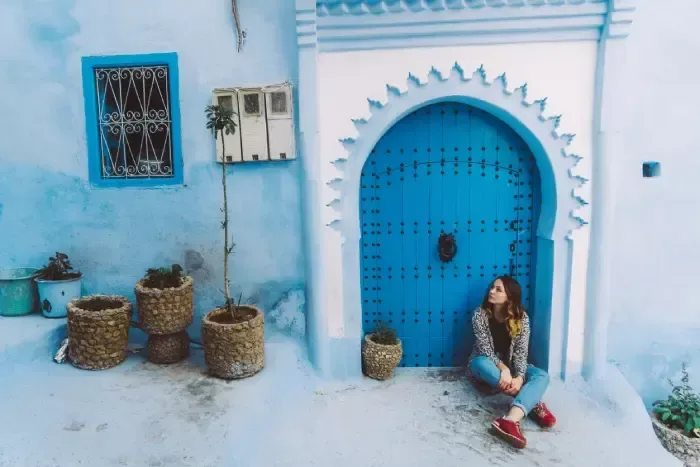
4. Sunset over the Spanish Mosque
Located 15 mins walk from Medina, t is one of the best viewpoints in the city for watching the sunset.
You will get to hike to reach the top spot, but it is so easy though. Note that hiking in the middle of the day might be uncomfortable due to the heat and also the crowd.
It is recommended to head there for the sunrise, as there will be fewer crowds and it will be quieter.
5. A Walk along the River
This is a remarkable experience for you. It is definitely a must for those who want to spend some quality time alone or with some friends.
Head down from the waterfall area right towards the river, where there are all kinds of bridges, brooks, and artwork. You will be entertained on the way down.
There are plenty of cafes and stalls from where you can buy artwork and paintings.
Must-See Spots in Chefchaouen
Chefchaouen's architectural marvels stand as silent witnesses to centuries of cultural confluence, each stone and archway narrating tales of artistic brilliance and historical significance.
The historic medina
The medina, masterfully constructed against ancient mountain slopes, represents Morocco's finest preserved medieval settlements. Pristine thoroughfares, meticulously maintained through generations, showcase walls painted in mesmerizing azure hues. This chromatic tradition emerged from 15th-century Sephardic and Moorish refugees, fleeing Iberian persecution. Scholarly visitors will appreciate the trilingual historical markers adorning significant structures, offering profound insights into the city's architectural evolution.
Plaza Uta el-Hammam
Plaza Uta el-Hammam commands the city's heart, its stones once echoing with the thundering hooves of cavalry and clash of martial training. Two magnificent monuments dominate this historical stage: the Grand Mosque and the Kasbah. The mosque, dating from 1560, presents an architectural curiosity - its octagonal minaret draws inspiration from Sevilla's celebrated Torre de Oro. The earthen-hued Kasbah, erected in 1471, houses treasures within its Ethnography Museum - ancient armaments, historical photographs, and exquisite textiles telling tales of bygone eras.
Spanish Mosque viewpoint
The Spanish Mosque, a 1920s architectural testament, presents unparalleled vistas of Chefchaouen's azure tapestry. Perched majestically upon southeastern heights, this structure offers photographers nature's perfect canvas. Pilgrims begin their ascent at Bab El Onsar, crossing ancient bridges before climbing hallowed paths. Yet beneath its architectural splendor lies a tale of resistance - local inhabitants once shunned this sanctuary, deeming it ritually impure.
Local markets
The souk's rhythmic pulse beats thrice weekly, each market day offering unique treasures:
- Mondays herald Rif Valley farmers bearing nature's bounty
- Thursdays showcase artisanal craftsmanship and mountain herbs
- Saturdays present additional regional specialties
These bazaars maintain medieval trading traditions, offering merchandise at modest prices amid good-natured bargaining. Agricultural products arrive with morning dew still fresh, harvested at the precise moment of ripeness. Here, amidst animated haggling and familial gatherings, visitors witness authentic Moroccan life unfolding in its purest form.
FAQs
Q1. How long should I plan to stay in Chefchaouen?
Two full days are typically sufficient to experience the essence of Chefchaouen. This allows time to explore the medina, watch the sunset from the Spanish Mosque, and potentially take a day trip to nearby natural attractions. If you prefer a more relaxed pace, consider extending your stay to three days.
Q2. What's the best time of year to visit Chefchaouen?
Spring (March-May) and fall (September-November) offer the most pleasant weather conditions for exploring Chefchaouen. During these seasons, temperatures range from 13°C to 26°C, creating ideal conditions for wandering through the blue-painted streets and enjoying outdoor activities.
Q3. What are some must-see spots in Chefchaouen?
Key attractions include the historic medina with its distinctive blue-washed walls, Plaza Uta el-Hammam (the main square), the Spanish Mosque viewpoint for panoramic views, and the local markets. Don't miss the Grand Mosque with its unique octagonal minaret and the Kasbah, which houses an Ethnography Museum.
Q4. Are there any specific customs I should be aware of when visiting Chefchaouen?
Yes, it's important to respect local customs. Use the traditional greeting "salaam alaykum" when interacting with locals. When taking photographs, always ask permission before capturing images of people, especially women, and at religious sites. Also, be mindful of using your right hand for gestures and greetings, as the left hand is considered impolite in social situations.
Q5. What are some local food specialties I should try in Chefchaouen?
Chefchaouen's cuisine blends Moroccan, Mediterranean, and Spanish influences. Must-try dishes include tajine (a traditional meat stew), couscous, Moroccan salad with warm ingredients like Zaalouk and Taktouka, and Jben (a mild, white goat cheese unique to the region). For an authentic experience, consider dining at local restaurants like Molin'arte or Bab Ssour.

































